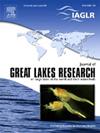Suspect screening and nontargeted analysis of polyfluoroalkyl substances in Lake Huron water and biota
IF 2.4
3区 环境科学与生态学
Q3 ENVIRONMENTAL SCIENCES
引用次数: 0
Abstract
Nontargeted analyses (NTA) have identified numerous unknown/novel per- and polyfluoroalkyl substances (PFAS) in water, aqueous film-forming foam, and commercial products, but few studies have used nontargeted approaches to analyze PFAS in aquatic organisms. This study employed NTA to investigate PFAS profiles in the Lake Huron water and biota, including zooplankton, dreissenid mussels, selected prey fish, and lake trout (Salvelinus namaycush). Five suspect perfluoroalkyl acids (PFAA) precursors and perfluoroethylcyclohexane sulfonate (PFECHS) were detected in the water and biota without the use of reference standards. Notably, N-ethyl perfluorooctane sulfonamido acetate (EtFOSAA) was detected in deepwater sculpin (Myoxocephalus thompsonii), PFECHS was detected in water and deepwater sculpin, and N-methyl perfluorooctanesulfonamido acetate (MeFOSAA) was detected in bloater (Coregonus hoyi). Different species are likely exposed to different PFAS due to variations in habitat and food sources. However, PFAS may also bioaccumulate in both prey and predator through foraging. To verify this hypothesis, unknown PFAS features observed in two or more composites from each species were isolated. The unknown PFAS with estimated concentrations >0.5 ng/g wet weight, and biomagnification factors (BMF) >1 were then isolated from all PFAS candidates detected in the food web components, particularly those identified in both prey and predator species. This subset of PFAS features was then slated for structural elucidation. A total of 66 unknown PFAS were detected in the biota and 19 in the water, with proposed structures containing carboxylic, ether, thiol, sulfonyl, amino, and amide groups.

休伦湖水体和生物群中多氟烷基物质的可疑筛选和非靶向分析
非靶向分析(NTA)已经在水、水成膜泡沫和商业产品中发现了许多未知的/新的单氟烷基和多氟烷基物质(PFAS),但很少有研究使用非靶向方法来分析水生生物中的PFAS。本研究采用NTA方法研究了休伦湖水体和生物群的PFAS分布,包括浮游动物、贻贝、精选猎物鱼和湖鳟(Salvelinus namaycush)。在没有使用参考标准的情况下,在水和生物群中检测到五种可疑的全氟烷基酸前体和全氟乙基环己烷磺酸。值得注意的是,深水雕塑(Myoxocephalus thompsonii)中检测到n -乙基全氟辛烷磺酰胺乙酸酯(EtFOSAA),水中和深水雕塑中检测到pechs,腹水(Coregonus hoyi)中检测到n -甲基全氟辛烷磺酰胺乙酸酯(MeFOSAA)。由于栖息地和食物来源的不同,不同物种可能暴露于不同的PFAS。然而,PFAS也可能通过觅食在猎物和捕食者体内进行生物积累。为了验证这一假设,从每个物种的两个或多个复合材料中分离出未知的PFAS特征。然后从食物网成分中检测到的所有候选PFAS中分离出估计浓度为0.5 ng/g湿重的未知PFAS和生物放大因子(BMF) >1,特别是在猎物和捕食者物种中发现的PFAS。然后对PFAS特征的这个子集进行结构说明。在生物群中共检测到66种未知PFAS,在水中检测到19种未知PFAS,其结构包含羧基、醚基、巯基、磺酰基、氨基和酰胺基。
本文章由计算机程序翻译,如有差异,请以英文原文为准。
求助全文
约1分钟内获得全文
求助全文
来源期刊

Journal of Great Lakes Research
生物-海洋与淡水生物学
CiteScore
5.10
自引率
13.60%
发文量
178
审稿时长
6 months
期刊介绍:
Published six times per year, the Journal of Great Lakes Research is multidisciplinary in its coverage, publishing manuscripts on a wide range of theoretical and applied topics in the natural science fields of biology, chemistry, physics, geology, as well as social sciences of the large lakes of the world and their watersheds. Large lakes generally are considered as those lakes which have a mean surface area of >500 km2 (see Herdendorf, C.E. 1982. Large lakes of the world. J. Great Lakes Res. 8:379-412, for examples), although smaller lakes may be considered, especially if they are very deep. We also welcome contributions on saline lakes and research on estuarine waters where the results have application to large lakes.
 求助内容:
求助内容: 应助结果提醒方式:
应助结果提醒方式:


